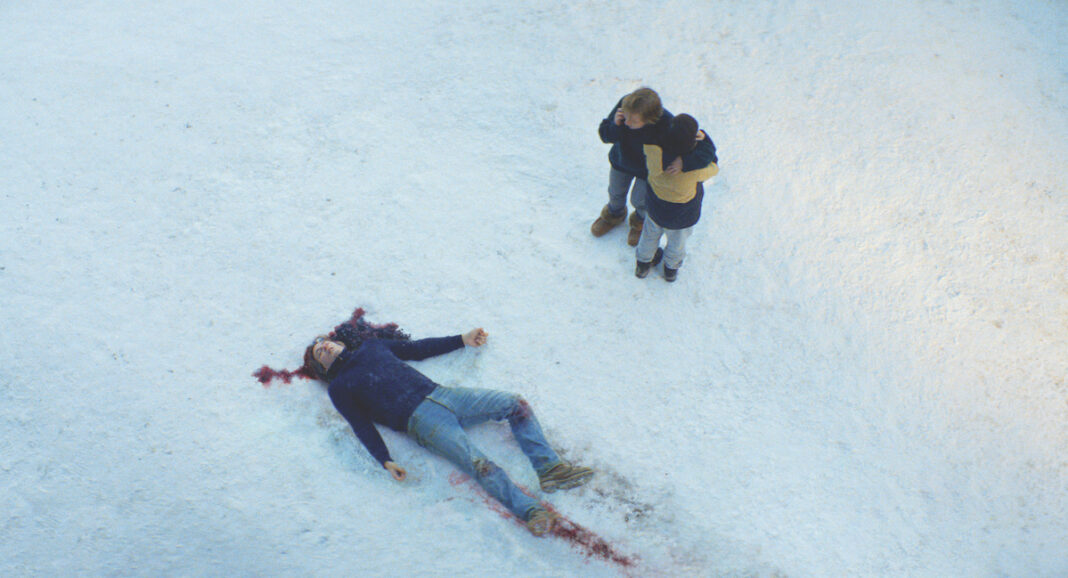One afternoon in the French Alps near Grenoble, an 11-year-old boy named Daniel and his dog Snoop discover the dead body of Daniel’s father, Samuel, lying on the ground at the base of the family chalet. Daniel is blind. His cries bring his mother Sandra to the scene, and eventually the police investigate Samuel’s death as a possible homicide. How did the man end up there, with a head wound bleeding into the snow, four stories below an open window in the chalet’s attic?
Anatomy of a Fall (Anatomie d’une chute) turns out to be more than just a murder mystery. In the hands of French director Justine Triet—working from a screenplay she wrote with Arthur Harari—the death of Samuel unleashes a wave of painful memories and conflicted feelings for both Daniel and Sandra. It’s a splendid actors’ vehicle starring artists American audiences are not accustomed to seeing. More than that, it’s one of the year’s best-written screen dramas.
From its first scenes, the family story is established as a stressed-out ordeal. Daniel’s mother, Sandra (Sandra Hüller), is being interviewed at home in the chalet, in connection with her new book—“a mixture of truth and fiction,” as she describes it. But the in-person discussion is interrupted by piercingly loud music from the upper floors—“P.I.M.P.,” by 50 Cent—so much so that the interview has to be postponed. Daniel’s father, Samuel (Samuel Theis), a would-be writer and musician, is evidently up to his familiar attention-grabbing antics.
A few moments later, Daniel (Milo Machado Graner), led by his beloved border collie, is guided to his father’s corpse. The police have questions, particularly about the trauma injury to Samuel’s head. Did it come from the fall, when he landed on the shed in the yard? Or did it occur from a blow to the head before Samuel plunged from the window? And what about that prominent bruise on Sandra’s arm?
The cause of death is ruled inconclusive and, furthermore, the evidence suggests the fall was not accidental. Suddenly Sandra emerges as the defendant. From that point forward Anatomy of a Fall essentially becomes a courtroom drama, suspensefully punctuated by flashbacks illustrating not only Sandra’s role in her troubled relationship with Samuel, but also the pathetic plight of their son.
By all appearances Daniel is a quiet, introspective boy devoted to practicing the piano. “Asturias,” from Isaac Albeniz’ Suite Española, amounts to something of an obsession with him. The sensitive Daniel also enjoys playing duets with his mother. And yet, in courtroom testimony, Sandra admits that the relationship with her son had taken second place to the “intellectual stimulation” she received from her late husband in their early years together. It’s further revealed that Daniel’s blindness was caused by an accident. He was struck by a motorcycle in the street after being picked up late from school—his father’s fault—and the guilt for that tragedy has resonated through the family life.
In the film’s most lacerating scene, a flashback reveals that Samuel was a childish, unstable personality prone to capricious mood swings, who among other things resented his German immigrant wife’s use of English as a useful common language at home. Sandra’s characterization as essentially a stranger in France even surfaces in the courtroom, with suggestive remarks by the judge that seem to present the defendant as the object of subtle chauvinism. Such is the Pandora’s box of evidence and conjecture that come into play as the murder trial proceeds.
Sandra’s attorney, Vincent (Swann Arlaud), emerges as a key figure in the scenario, vigorously defending his client against the slippery innuendo of the prosecutor (Antoine Reinertz), who doggedly tries to fit the calm Sandra into a box. Secrets are revealed. Innermost emotions erupt. But Anatomy of a Fall provides no easy answers. With exquisite timing, filmmakers Triet and Harari paint a narrative portrait as complex and multi-layered as life itself. Chapeau!
In theaters











